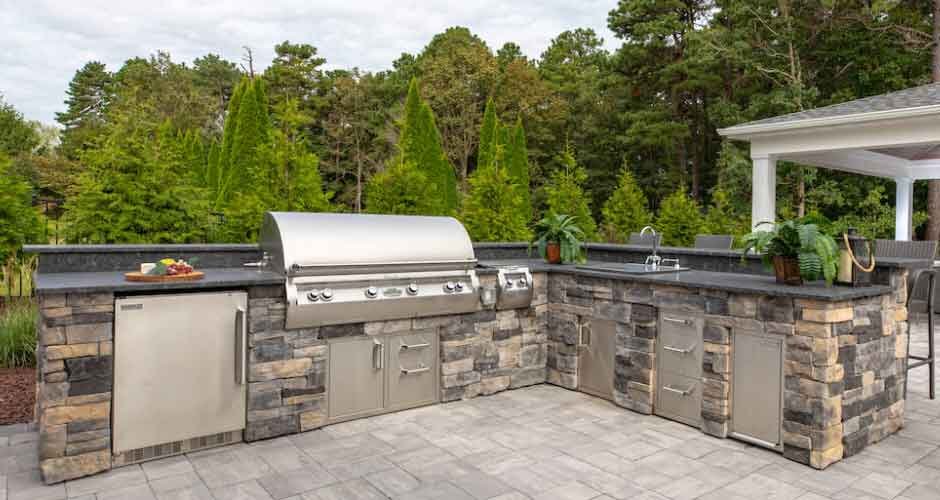In recent years, the idea of an outdoor kitchen has become increasingly popular as more homeowners look to expand their living areas outside of their indoor environments. Consideration must be given to both functionality and aesthetics when designing an outdoor kitchen. These crucial design pointers will assist you in creating an exquisite and useful outdoor kitchen that blends in perfectly with your outdoor living area.
1. Strategic Layout Planning
Structuring your outdoor kitchen should be the first step in the design process. Taking into account the organic flow of your outdoor area, arrange the kitchen such that it enhances the entire aesthetic. This means that the chef and guests will have a seamless and convenient experience if cooking sections are situated adjacent to dining and seating areas. You can also use top-rated outdoor kitchen kits for your kitchen that will add an elegant look to your home.
As an example, put the countertop, sink, and grill together to enhance efficiency. The outdoor kitchen’s overall aesthetic appeal is enhanced by this well-thought-out arrangement, which also improves utility.
2. Durable Materials Selection
Material selection is an important part of the design process for outdoor kitchens because they are subjected to a variety of weather conditions. Choose materials that are strong and resistant to weather so that your outdoor kitchen will last a long time and look good.
Because it resists corrosion and requires little upkeep, stainless steel is a great material for countertops and appliances. Likewise, weatherproof woods that offer a hint of warmth to an outdoor area, such as teak and cedar, are perfect for cabinets.
3. Ample Storage Solutions
A common mistake in outdoor kitchen design is to undervalue effective storage. Sufficient storage capacity keeps the kitchen well-organized and guarantees that necessary equipment, supplies, and utensils are accessible. Include drawers and cabinets in the layout to hold these things and shield them from the weather while not in use.
Think about movable storage options like integrated utensil compartments and trash cans that slide out. This meticulous attention to detail improves the outdoor kitchen’s functionality and fosters a seamless and pleasurable cooking experience.
4. Thoughtful Lighting Design
Designing a functional and hospitable outdoor kitchen requires careful consideration of lighting. To install lighting in the dining and cooking areas, combine ambient and task lighting. With carefully placed outside sconces and string lights, the area is made feel cozy and inviting. Pendant lights over the countertop and grill give focused illumination.
Make use of energy-efficient LED lighting fixtures, which also add to the outdoor kitchen’s overall visual appeal while improving visibility. Enjoyable outdoor cooking and entertaining are made possible by the thoughtful lighting design, which extends the space’s value well into the evening.
5. Integrating Natural Elements
Design with natural components to create a seamless connection between your outdoor kitchen and the surroundings. Establish a smooth transition between the inside and outside spaces with landscaping and hardscaping.
To offer shade and define the kitchen area, think about adding a pergola or canopy. The earthy touch of natural stone or brick finishes on the counters and floors enhances the outdoor kitchen’s overall visual appeal.
6. Weather Protection Considerations
While outdoor kitchens are great for eating, it’s important to think about how to keep the weather out. Provide shade from the sun and rain by building a sturdy, fashionable pergola or other overhead structure. This guarantees the outside space’s functionality in a variety of weather conditions, in addition to safeguarding the kitchen’s appliances and furniture.
Pick materials and furniture that can tolerate exposure to dampness and sunshine that are weatherproof. This careful consideration of weather protection increases your outdoor kitchen’s endurance and durability.
7. Seamless Connectivity and Entertainment
To improve the entertaining experience, smoothly incorporate technology into the design of your outdoor kitchen. To create a lively and captivating ambiance, think about adding outdoor speakers or a television that can withstand the elements. You can use this connectivity to watch or listen to your preferred music while cooking or hosting visitors.
Make sure that the design of the outdoor kitchen provides easy access to power outlets for electronics and appliances. Because of its focus on connectivity, the outdoor kitchen becomes a multipurpose area for entertaining and cooking.
Conclusion
A delicate balance between practicality, aesthetics, and utility is required when designing an outdoor kitchen. The following are crucial factors to take into account: a well-planned layout, strong materials, lots of storage, intelligent lighting, natural elements, weather protection, and seamless connectivity. You can build an outdoor kitchen that not only satisfies your culinary requirements but also raises the quality of your outdoor living area by implementing these design suggestions.



